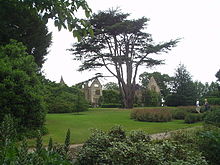- Nymans
-
 Marginally hardy exotics thrive in Nymans' sheltered microclimates
Marginally hardy exotics thrive in Nymans' sheltered microclimates
Nymans, Handcross, Haywards Heath, West Sussex, is an English garden developed by three generations of the Messel family, from the late 19th century, and brought to renown by Col. Leonard C.R. Messel. Nymans, since 1953 a National Trust property,[1] is the origin of many sports, selections and hybrids, both planned and serendipitous, some of which can be identified by the term nymanensis, "of Nymans". Eucryphia × nymansensis (E. cordifolia × E. glutinosa) is also known as E. "Nymansay". Magnolia × loebneri 'Leonard Messel', Camellia 'Maud Messel' and Forsythia suspensa 'Nymans', with its bronze young stems, are all familiar shrub to gardeners.
In the late 19th century, Ludwig Messel, a member of an unusually creative German family settled in England family, bought the Nymans estate, a house set in 600 acres on a sloping site overlooking the picturesque High Weald of Sussex, to make a setting for family life and entertainments, with Arts and Crafts-inspired "garden room" planning where topiary features contrast with new plants from temperate zones around the world. Messel's head gardener from 1895 was James Comber, whose expertise helped form plant collections at Nymans of camellias, rhododendrons, which here, unusually at the time, were combined with plantings of heather (Erica) eucryphias and magnolias. William Robinson advised in establishing the Wild Garden.[2]
His son Lt. Col. Leonard Messel, succeeding to the property in 1915, replaced the non-descript Regency house with the picturesque stone manor, designed by Sir Walter Tapper and Norman Evill in a mellow late Gothic/Tudor style. He and his wife Maude extended the garden to the north and subscribed to seed collecting expeditions in the Himalayas and South America.
The garden reached a peak in the 1930s and was regularly opened to the public. The severe reduction of staff in World War II was followed in 1947 by a disastrous fire in the house, which survives as a garden ruin.
The house was partially rebuilt and became the home of Leonard Messel's daughter[3] Anne Messel and her second husband the 6th Earl of Rosse. At Leonard Messel's death in 1953 it was willed to the National Trust with 275 acres of woodland, one of the first gardens taken on by the Trust. Lady Rosse continued to serve as Garden Director.
The garden suffered much damage in the Great Storm of October 1987, losing 486 mature trees and many of the shrubs.[4] The pinetum, one of the garden's earliest features, was destroyed.[5] Restorations are ongoing.[6]
Notes
- ^ National Trust: Nymans.
- ^ Garden history of Nymans: Leonard Messel, A Garden Flora: Trees and Flowers Grown in the Gardens at Nymans, (1918); L.M.H. Parsons 1971 "The gardens at Nymans". Journal of the Royal Horticultural Society 96.11) (1971: 482-491); A.P.M. Rosse, Nymans: The Home of the Earl and Countess of Rosse, (National Trust, 1973); A. Rosse and A. Buchanan, Nymans, West Sussex (National Trust, 1990); Shirley Nicholson, Nymans: the story of a Sussex garden (1992);
- ^ His son, her brother, was the set designer Oliver Messel.
- ^ GardensToGo: Nymans.
- ^ TourUK:Nymans
- ^ John Cornforth, "Nymans, Sussex: The National Trust's restoration of romantic ruins at the centre of a spectacular garden", Country Life (1997)
Categories:- National Trust properties in West Sussex
- Gardens in England
Wikimedia Foundation. 2010.


